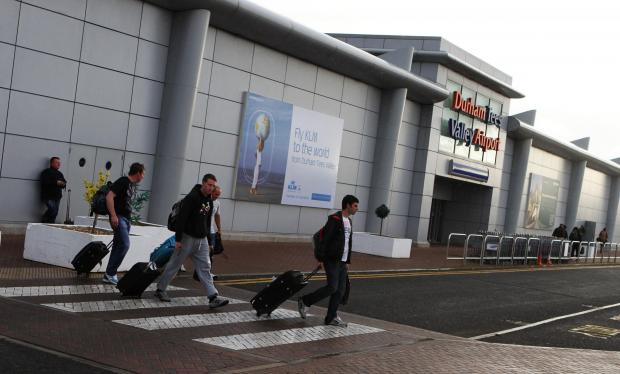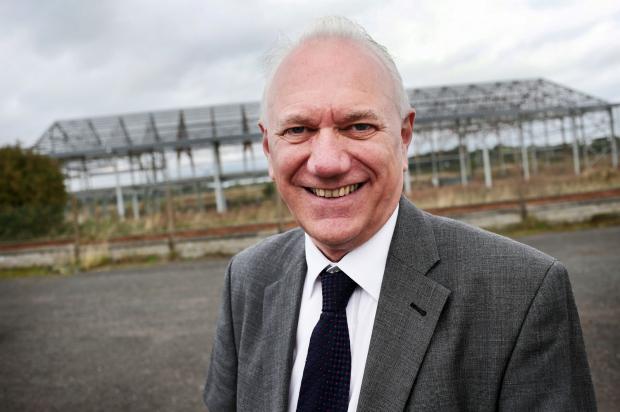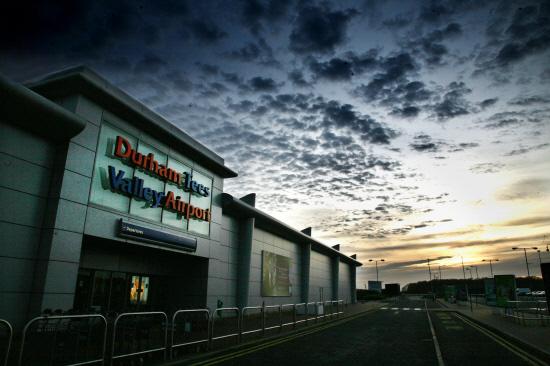Failing Durham Tees Valley airport new “Master Plan”; sound strategy – or a last throw of dice?
Durham Tees Valley airport, owned by Peel Holdings, has been doing very badly in recent years. It has twice failed to secure government funding for its expansion, but has now bought land it says could be used for “engineering, storage and distribution operations”. Since February it has been involved in taking apart and recycling old planes. The airport’s management say they will shortly be putting out a Master Plan, which is an aspiration of how they would like the airport to develop. Peel Holdings said the proposals would safeguard the airport’s flights to Schiphol and Aberdeen. A local MP said “This must not become an excuse to transition it being an industrial estate that happens to have a runway.” An airport manager commented that few airports can survive from passenger traffic revenue only. Commentators say the Master Plan could be seen as either the last throw of the dice, or a viable and coherent strategy. Though it suggests the airport plans to develop the commercial potential to retain passenger services, the unstated implication is that the battle is lost. Changes in the market and the end of the low-cost air travel boom mean there is no need for another passenger airport between Leeds Bradford and Newcastle.
.
Tweet
Number of passengers in 2012 using Durham Tees Valley airport was around 165,000 while it was around 912,000 in 2006.
The airport itself has not put out any press releases since May 2013.
.
.
Durham Tees Valley Airport to reveal future blueprint
Bosses at Durham Tees Valley Airport are to open a consultation on a blueprint for the site’s future.
The airport, which has twice failed to secure government funding for its expansion, has now bought land it says could be used for “engineering, storage and distribution operations”.
Owner Peel Holdings said the proposals would safeguard the airport’s flights to Schiphol, Holland, and Aberdeen.
Stockton South MP James Wharton said he had some concerns about the plans.
“This must not become an excuse to transition it being an industrial estate that happens to have a runway,” the Conservative MP said.
“I want to see a focus on getting new routes and destinations. A few years ago we had nearly a million people going through that airport every year. That’s declined to just over a tenth of that.”
Airport strategic planning director Peter Nears said the purchase of land was “significant”.
He said: “Very few airports, even the largest, can survive alone from passenger traffic revenue and in the case of smaller airports such as Durham Tees Valley it is essential that they create diverse income streams.”
A fire training centre and an aircraft recycling business are among those based at the airport.
Peel twice made unsuccessful applications to the government’s regional growth fund.
http://www.bbc.co.uk/news/uk-england-tees-24441873
.
.
Sound strategy – or a last throw of dice?
11.10.2013
THE saga that is Durham Tees Valley Airport took a further twist this week. Owners Peel Holdings made a yet another statement about its future.
The announcement of a “masterplan” designed to ensure it remains open can be interpreted in two ways: the last throw of the dice, or a viable and coherent strategy.
Although the statement suggests that the plan to develop the commercial potential of the airport is designed to retain passenger services, the unstated implication is that the battle is lost. Changes in the market and the end of the low-cost air travel boom mean that there is no room for a passenger hub sandwiched between Leeds Bradford and Newcastle – both of which have expanded in recent years at Durham Tees Valley’s expense.
The plan, according to the statement, is all about attracting more aviation-related businesses to the site, like the existing international fire training centre and the aircraft recycling operations.
Peel’s purchase of more land adjacent to the airport would suggest that their long-term intentions have some substance.
But there is also in the statement something of a challenge to the community around the airport and what Peel calls its key partners – principally the local authorities, including Durham County Council, which still have small stakes in the airport.
It wants to develop the large landholdings around the airport – something it has failed to do in the past with plans for a freight operation on the south side of the runway. There’s a range of other business operations Peel wants to explore but that will require the consent of the neighbours and those key partners.
The message is clear: we will endeavour to keep the airport open but it will require local business, councils’ and the residents’ support.
http://www.thenorthernecho.co.uk/archive/2013/10/11/10734150.Local_support_vital/
.
Terminal Passengers:
UK Airport Statistics: 2012 – annual (Table 10.3) Terminal Passengers 2002 – 2012
2006 912,000
2005 902,000
2000 740,000
1996 429,000
.
Durham Tees Valley Airport master plan gets local authority backing
9th October 2013
By Joe Willis, Regional Chief Reporter (Northern Echo)

LOCAL authority leaders have given a cautious welcome to a rescue plan for Durham Tees Valley Airport (DTVA).
Business and regeneration chiefs have also backed Peel Holdings’ apparent commitment to stand by the ailing airport.
The Northern Echo revealed yesterday how Peel would shortly publish a master plan setting out how DTVA could have a sustainable future.
It is hoped the turnaround plan could protect scheduled flights from the airport, although it is understood holiday charter flights could be sacrificed to reduce costs.
“The plan appears to deliver what we’re all after which is an airport which is self-sustaining.
“From a local authority and economic point of view, I would be extremely keen to see the retention of the air links to Schiphol and the oil fields.”
George Dunning, leader of Redcar and Cleveland Borough Council, also a DTVA board member, added: “Scaling down the airport may well keep the airport viable and flexible enough to take advantage of any substantial upturn in the commercial flight part of the airport business.
“One can understand fears that the airport shouldn’t turn into an industrial estate. That’s why we need local authority directors on the board of the airport to scrutinise plans etc, however one should not be frightened to allow some diversity.”
Councillor Mike Smith, Stockton Council’s cabinet member for regeneration and transport, said economic conditions had been tough for regional airports in recent years.
“We recognise that Peel Holdings have been working hard to secure a sustainable future for Durham Tees Valley Airport,” he added.
Last night, North East Chamber of Commerce infrastructure policy specialist, Mark Stephenson, said it was “reassuring” that Peel remained committed to maintaining the link to Schiphol.
He added: “The airport is an important part of the region’s connectivity mix and, as such efforts must be made to secure its future and help it realise its potential as a regional transport hub.”
Tees Valley Unlimited said it was important that DTVA had a vision for a successful future.
The local enterprise partnership said it would maintain an “open dialogue” with Peel as the master plan progressed.
.
.
.
Durham Tees Valley Airport master plan ready for take off
8th October 2013
By Joe Willis, Regional Chief Reporter (Northern Echo)
 MASTER PLANNER: Peter Nears, Peel strategic planning director, near new land purchased at the airport.
MASTER PLANNER: Peter Nears, Peel strategic planning director, near new land purchased at the airport.A PLAN to ensure the survival of scheduled passenger flights from Durham Tees Valley Airport (DTVA) will be published within weeks – amid fears that holiday charter flights could be sacrificed.
The future of the ailing airport has been called into question after a massive drop in passenger numbers and the loss of key routes.
But last night majority shareholder Peel Holdings indicated that it was still prepared to stand behind the loss-making business and was drawing up a turnaround plan.
Peel believes the plan will safeguard the future of scheduled daily services to the international hub at Schiphol, in Holland, and shuttle flights to Aberdeen.
However, the future of seasonal charter flights to popular holiday destinations, such as Marjorca and Jersey, are understood to be under threat. Although no final decision has been taken, package holiday flights may be axed to cut costs and help realign the airport as a commercially-biased operation.
MPs welcomed news of a turnaround plan last night but one warned: “This must not turn into a plan to transition the airport into an industrial estate.”
Peter Nears, Peel’s strategic planning director, said the rescue plan would help the airport build on its strengths – including its large landholding and the existing businesses.
He said: “Of course, everyone recognises that the past few years have been tough for Durham Tees Valley but the master plan is all about ensuring that we have the right business model to take the airport forward and reflect the significant changes in the market over the last decade.
“That is how we can best safeguard the airport and the vital services it provides, especially to the local business community who require international connections.”
Mr Nears said even the largest airports could not survive on passenger traffic revenue alone.
“In the case of smaller airports such as Durham Tees Valley it is essential that they create diverse income streams—and here the availability of development land is a major strength and will enable further investment in airport operations.”
As part of the redevelopment plans, the airport has recently bought a 9.5-acre former aircraft hangar, which was more recently used as a tennis centre, on the edge of the airport site near the rail station.
It is hoped the land will be suitable for an aviation-related engineering, storage or distribution operation.
Mr Nears said: “The draft plan we will be publishing in the near future sets out what we believes is a very positive vision – creating a vibrant and sustainable business as a stable and secure basis for ongoing investment in order that the development of Durham Tees Valley Airport is feasible and can be funded.”
The plan will go out for consultation next month.
Local MPs who have been briefed on the blueprint have been told that while the long-term future of scheduled flights is secure, the airport could decide to stop handling holiday charter flights in a bid to reduce costs.
This summer passengers have been able to fly to destinations including Majorca, Verona and Jersey, with Ibiza and Bulgaria among the locations planned for 2014.
Darlington MP Jenny Chapman said: “I think it’s been a very bumpy ride over the last few years and now for the first time we can see viable long-term plan.”
Sedgefield MP Phil Wilson also backed the blueprint.
“It seems to me that Peel are going to make a go of the airport. It’s losing money at the moment and that can’t continue.”
James Wharton, Stockton South MP, said he was pleased Peel was planning for the future.
However, he added: “This must not turn into a plan to transition the airport into an industrial estate.”
The airport said last night that no firm decisions had been taken regarding charter flights.
.
History of Durham Tees Valley Airport’s grand plans
8th October 2013
By Joe Willis, Regional Chief Reporter (Northern Echo)

AS fresh plans to develop Durham Tees Valley Airport (DTVA) are due to be published, Joe Willis looks back at previous schemes which failed to take off.
MOST visitors to DTVA see little more than the car park and terminal building, but beyond the fence can be found numerous businesses which have made the former RAF airfield their home.
It is these companies – and those yet to arrive – which it is hoped will secure the future of national and international flights to and from the Tees Valley.
The aim is to increase income into the airport by expanding existing companies and attracting new aviation-related firms to the site.
Although this is the first time a master plan has been drawn up for the airport, previous grand plans to develop the large areas of land around the runway and terminal have been published previously.
Back in 2003 after Peel bought the airport from local councils, Peter Nears, the man behind the new airport master plan, said the company wanted to develop 250 acres alongside the airfield into business and industrial parks – a plan which had already been proposed by the previous public sector owners.
Former airport managing director Hugh Lang said at the time that the benefits of developing the land at the south of the airport – known as the Southside scheme – were “unfathomable”.
More details were revealed two years later when the airport announced plans to create up to 2,500 jobs in a £56m scheme which included the creation of a hotel, air freight operation and business park. The following year, work on a £1.3m revamp of the terminal building took place.
However, in 2008 the £110m Skylink International Business Park was announced to replace the Southside project. Unfortunately this scheme too stalled at the drawing board stage due to a lack of funding and fears about the economic climate.
Fast forward to 2012 and the airport suffered another blow when Peel failed with a £5.9m
bid to the Government’s Regional Development Fund to resurrect the Southside freight operation. The following year a second bid for £4.65m from the same pot was again rejected.
Despite a decade of disappointment, hopes remain that the airport master plan due to be revealed next month will signal a viable new future for the airport.
.
.
Durham Tees Valley aircraft recycling starts
19 February 2013 (BBC)
A new business has come to Durham Tees Valley Airport after bosses reported dwindling passenger numbers.
An aircraft dismantling and recycling company has been set up on the airfield and is currently taking apart two old Russian aircraft.
http://www.bbc.co.uk/news/uk-england-21506847
.
.
.
